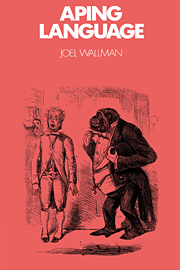
-
Select format
-
- Publisher:
- Cambridge University Press
- Publication date:
- November 2009
- October 1992
- ISBN:
- 9780511611858
- 9780521404877
- 9780521406666
- Dimensions:
- (228 x 152 mm)
- Weight & Pages:
- 0.429kg, 204 Pages
- Dimensions:
- (228 x 152 mm)
- Weight & Pages:
- 0.43kg, 204 Pages
- Subjects:
- Linguistic Anthropology, Sociology: General Interest, Sociolinguistics, Anthropology, Language and Linguistics
- Series:
- Themes in the Social Sciences
You may already have access via personal or institutional login- Subjects:
- Linguistic Anthropology, Sociology: General Interest, Sociolinguistics, Anthropology, Language and Linguistics
- Series:
- Themes in the Social Sciences
Book description
Language is regarded, at least in most intellectual traditions, as the quintessential human attribute, at once evidence and source of most that is considered transcendent in us, distinguishing ours from the merely mechanical nature of the beast. Even if language did not have the sacrosanct status it does in our conception of human nature, however, the question of its presence in other species would still promote argument, for we lack any universally accepted, defining features of language, ones that would allow us to identify it unequivocally ours from other species and contention over the crucial attributes of language are responsible for the stridency of the debate over whether nonhuman animals can learn language. Aping Language is a critical assessment of each of the recent experiments designed to impact a language, either natural or invented, to an ape. The performance of the animals in these experiments is compared with the course of semantic and syntactic development in children, both speaking and signing. The book goes on to examine what is known about the neurological, cognitive, and specifically linguistic attributes of our species that subserve language, and it discusses how they might have come into existence. Finally, the communication of nonhuman primates in nature is assayed to consider whether or not it was reasonable to assume, as the experimenters in these projects did, that apes possess an ability to acquire language.
Reviews
"Its strength lies in the overview it provides of the methods, theory, and results of this work, and in its potential to assist in bringing methodological improvement and conceptual clarification to future work on the linguistic abilities of apes and other animal species." American Journal of Primatology
"The strength of this book is that it provides a concise review of the theory, methods, data, and resulting interpretations....Wallman has written a useful summary and critique." American Journal of Physical Anthropology
"A well-written book." E. Delson, Choice
"The outline of Wallman's book is straightforward....His treatment of the controversies surrounding the success of the programs, indeed surrounding the possibility of demonstrating language in nonhumans, is vivid. There is both vitriol and passion here, suggesting that the issues go far beyond the data....Wallman's narrative is both scholarly and entertaining....enjoyable and elegant." Contemporary Psychology
"...a conscientious, rational book that not only reviews the many and varied 'ape language' experiments of the last two decades, but reviews the copntroversy itself." Semiotica
Contents
Metrics
Altmetric attention score
Full text views
Full text views help Loading metrics...
Loading metrics...
* Views captured on Cambridge Core between #date#. This data will be updated every 24 hours.
Usage data cannot currently be displayed.
Accessibility standard: Unknown
Why this information is here
This section outlines the accessibility features of this content - including support for screen readers, full keyboard navigation and high-contrast display options. This may not be relevant for you.
Accessibility Information
Accessibility compliance for the PDF of this book is currently unknown and may be updated in the future.


